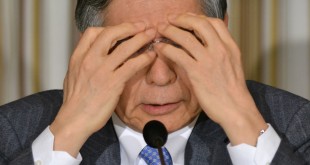For those who follow biotechs and pharma, Clovis Oncology was a casualty of an FDA request for more information, which happened not long after rival AstraZeneca had a competing drug approved. Normally such a story ends the interest of most speculators but I posted about Zachary Schreiber’s recent purchase of 7.7 percent of Clovis as a heads up that the recent dumping may have been an opportunity to buy. Schreiber’s is well known in trading circles for his $1B USD profit from shorting crude oil and for having been a protege of hedge fund legend Stanley Druckenmiller.
Not long after Schreiber’s Clovis position was filed, another successful and smart investor, Kyle Bass, who made about half-a-billion dollars from fading the housing bubble, discussed Clovis. (History recap for those of you who just became legal to drink, about a decade ago, Bass had taken the other side of a trade against synthetic CDO managers who underwrote de facto insurance against the default of Collateralized Debt Obligations (CDOs). CDOs were those bundle of mortgages, which were created in mass quantities and gobbled up by institutional investors, thanks to the roller-brush rating blessings of rating agencies, even if not all the mortgages were of equal quality. But I’m getting away from Clovis.) Not long after the internet masses starting talking about this appraisal of Clovis, I read this fascinating research late last Tuesday evening but then the ramp-up to “National Feast” festivities took over. Before I make another roast turkey sandwich, I wanted to assemble some very imperfect notes to help me learn, think, and help me work out in my mind what is going on with Clovis.
Before you go any further, please read my earlier notes from my initial post on Clovis Oncology. That might serve as a warm-up prequel to this post.
What follows is a collection of thoughts as I work my way through both the science and the business elements of this “story”.
Some initial takeaways from my readings:
First, to oversimplify: the assertion about Clovis’ lower rates of success may not be entirely fair. AstraZeneca had apparently had more Asian subjects in its Tagrisso trials, resulting in a more successful looking drug. This looks like a very material issue. From what I could gather from the analysis, and then looking into what the oldest organization focused on the study of lung cancer had to say, based upon the potential rates of disease and responsiveness to treatment among Asians afflicted with lung cancer, there may be an imperfect understanding of the competition between Clovis and AstraZeneca.
Second, again to oversimplify: it occurs to me that the question of Clovis’ lead lung cancer drug, Rociletinib, working or not is not the issue. It does seem to work but I think the wrinkle became the issue FDA’s request for more info. This wrinkle was thanks to the nature of the data submitted by Clovis as it was building its Tiger drug trials – which included both confirmed responses and unconfirmed responses by subjects. It looks like Clovis was optimistic and had expected a higher conversion. What looks like management’s complete screwup, regarding the usage of “confirmed” and “nonconfirmed” objective response rate (“ORR”) data, is being mixed up with the separate issue of drug efficacy. has potentially jeopardized Clovis’ breakthrough drug status for Rociletinib but not killed it yet. It looks like they will work to make good and supply more information but the market has said, “too little, too late”. This is moot given that rival AstraZeneca’s Tagrisso was not only approved, but was approved about 3 months earlier than expected, and that might be the wedge which hurts what could be a delayed approval of Rociletinib. One complication about these medications becomes the issue of mutation and resistance, and while might well be a place for Rociletinib for patients who become resistant to other treatments but I’m not sure if that is enough to help Clovis catch up.
(Post-script: An attentive reader pointed out, respectfully (thank you for not taking off my head), that I made an error by pointing out logically that it is essentially moot if both confirmed and unconfirmed data is presented to the FDA, since “efficacy” has to be based upon “confirmed” ORR data. I lack the correct terminology but I have been influenced by Bass’ argument, that they do in fact have a candidate that could potentially be approved but now they have to work in the aftermath, and under the shadow of having submitted “nonconfirmed” data which prompted the FDA’s actions. This is what I meant by “separate issue” – there could be a drug that proves its efficacy but now the company has to try again but had provoked Mr. Market into dumping shares. The error is mine and thank you reader.)
So where is the value? Why in the world am I talking about what really does seem to be a disastrous pharma investment? Yes, one company might have “gamed” the system with how it populated its trial but right now the other company may have not only missed its opportunity to do likewise (assuming it was even allowed to do so) but made things worse by being way too optimistic that the “nonconfirmed” subjects would convert at a high enough rate to “confirmed”. I have to admit my interest comes down to two non-medical investment professionals. Normally, I would have taken a pass on a “knife” but it’s not everyday you see someone like a Zachary Schreiber come in to buy a little over 1/14 of a company and then see another analytical machine, like Kyle Bass, who built a career on independent and insightful analysis (as far back as his early days at Bear Stearn’s Dallas office) on “shorts”, come in with a buy analysis. It’s weak beer to admit that but it I’m taking their actions seriously enough to spend time on this and risk wasting yours.
My interest in Clovis was inspired by Zachary Schreiber’s 7.7 percent position. Nobody throws away money and Schreiber is a big picture investor who Druckenmiller sees as a possible market wizard (“market wizard” is my characterization not Druckenmiller’s) in next 15 years or so. It’s a little daunting to look into some serious science but it looks like this is a real, and not pie-in-the-sky, pharma investment opportunity,with real drugs coming to market. As part of this, I am making best efforts to understand why some smart money is interested in Clovis, after a massive market price decline, with a little help from wikipedia and Google.
Let me return for a moment about what I was getting at about the number of Asians in both Clovis’ and AstraZeneca’s trials.
“The International Association for the Study of Lung Cancer (IASLC) is the only global organization dedicated to the study of lung cancer. Founded in 1974, the association’s membership includes nearly 4,000 lung cancer specialists in 80 countries. IASLC members work to enhance the understanding of lung cancer among scientists, members of the medical community and the public. IASLC publishes the Journal of Thoracic Oncology“.
From the March 2015 issue of the Journal of Thoracic Oncology:
“Non–small-cell lung cancer (NSCLC) accounts for approximately 85% of lung cancers,1 with an estimated 1.8 million new lung cancer cases worldwide in 2012, including 1 million cases in the Southeast Asian and Western Pacific regions combined.2
Recent advances in lung cancer research have resulted in the identification of several mutations that contribute to carcinogenesis of NSCLC.1,3 The epidermal growth factor receptor (EGFR) is encoded by one of the most commonly mutated genes in NSCLC, with activating mutations detected in up to 15% of adenocarcinoma (ADC) and less than 5% of squamous cell carcinomas (SCC) within the Caucasian patient population.1,4 Mutation rates are higher in Asian populations, with EGFR mutations reported in up to 59% of ADC and 5.4% of SCC cases.5 “
My reaction to that macro data: What would Clovis’ results have been like if the trials had taken place in an Asian market?
Last week’s reading about Clovis points out that AstraZeneca seemed to have 3 times as many Asian test subjects for its Tagrisso drug trial than Clovis had for testing Rociletinib. (I have questions about why the composition of the study groups were different.)
Quick notes on lung cancer. These are by no means complete notes on the subject and I apologize for inaccurate and incomplete notations.
There are two main types of lung cancer:
(1) Small cell which makes up 10-15% of lung cancers
(2) Non-small cell (NSCLC) which makes up 85-90% of lung cancers (a/k/a: NSCLC). Adenocarcinoma (40%), Squamous cell carcinoma (25-30%) and large cell (10-15%) are the 3 leading types of NSCLC.
Clovis’ Rociletinib was intended precisely for EGFR mutation-related “non-small cell lung cancer” (a/k/a “NSCLC”) and it looks like management had challenges with both handling the data as well as with how the study was populated. I will need to look deeper into this and see if I understand what happened with management. Clovis may in fact have a drug competitive with AstraZeneca for all we know but we are dealing with two data sets, with two differently composed study groups. “Apples and oranges” may be the problem here.
Turning very quickly to the valuation estimates: I read them with a grain of salt but I am fascinated by the mechanics of such an estimate and if they are in the ballpark then Clovis, at recent prices, is an attractive investment idea.
Scenario 1: Clovis could be $45 a share upon approval of a second drug under development, Rucaparib which was not subject to the FDA info request, while leaving open the possibility that former favorite turned “problem child”, Rociletinib, could still be approved.
An oversimplified description of Rucaparib from my reading of Clovis’s info: Our DNA gets damaged and we have systems that repair our DNA to prevent mutations and cancer. Sometimes we get cancer because the damage cannot be undone readily. In fact, cancer cells themselves can stay alive through similar “repair” mechanisms. Poly ADP-ribose polymerase (PARP) initiates a process which quickly repairs DNA during the early stage of damage, and this is part of how cancer cells keep themselves alive. Rucaparib is a PARP “inhibitor”, and could prevent cancer cells from repairing themselves. “In the absence of PARP, cells are unusually sensitive to DNA damage when exposed to radiation or DNA-alkylating agents.” The idea is that radiation and chemotherapy’s work won’t be undone by cancer cells repairing themselves. Analogy: the ground troops of radiation/chemo get air support from drugs like Rucaparib.
The FDA granted Rucaparib “breakthrough drug” status for treating ovarian cancer , which is from my early reading, is the seventh most common form of cancer and eighth most common cause of cancer-related deaths.
The anchor steadying this scenario is that Rucaparib could be approved in 2016. Rucaparib, unlike its sister drug under-development Rociletinib, is not the drug under increased market scrutiny and skepticism and which caused Clovis shares to collapse to the mid-20s per share. This seems to be a “baby thrown out with the bathwater” scenario.
As there is no immediate earnings, the valuation estimate which resonated for me was cash on the balance sheet, + guesstimated values of each drug, depending on what stage of development it was in.
Breakdown of Scenario 1 estimate: $8 per share + maybe $10 (up to $15) for FDA trouble child Rociletinib + $ maybe $25 (up to $30) for Ruciparib, with an estimated total ranging from $43 to $53. $45 is the suggested mid-guesstimate. NOTE: that $8/share should be the 600+M of cash then less the 287+M in convertible debt.
The cash + the middle child of Rucaparib, at current market values, offers a “call option” on the reformation of the problem child of Rociletinib. This situation seems to be a kind of value investing/stub stock play. Take out the trouble child and it’s $8 + $25 (to $30), or about $33 to $38 NOT including Rociletinib. I know it’s not $125 a share like not long ago but for you and me, the late comers, this is a big upside from the mid-20s handle.
Scenario 2: In a more forward looking, “growth” scenario, Clovis, over a longer period of time, could become $90 a share IF:
IF both lead oncology drugs, Rociletinib and Rucaparib could be shown to be used for other “indications” (treat other diseases )
OR
IF both Rociletinib and Rucaparib are in final stages for approval for their initial indications, while a third drug further behind in development, Lucitanib, goes to Phase 2. Lucitanib is an “inhibitor of the tyrosine kinase activity of fibroblast growth factor receptors” (a/k/a “FGFRs”).
(An attempt at understanding Lucitanib: My bad analogy is that fibroblast growth factor receptors are like USB ports on the surface of cancer cells. Tyrosine kinase activity refers to the “on/off” on cancer cells. Floating around are Fibroblast Growth Factors (FGFs) , which are proteins called ligands, floating around and finding their way toward the receptors. If these FGFs, these ligands, like a swarm of flashdrives, connect with the receptors, located like USB ports on the surface of cancer cells, then cancer cell growth follows. If my bad analogy holds then Luci is meant to interrupt the instructions cancer cells may receive to proliferate by turning the “on/off” switch to “off’ on the receptor, so that flashdrives don’t connect with usb ports and trigger cancer growth. End of bad analogy.)
Testing going back five years indicates Luci could be of help against breast cancer and lung cancer.
Breakdown of Scenario 2 estimate: $30 (Rociletinib for original + other “indications”, other applications) + $40 (Rucaparib same story) + $20 (Lucitanib has some kind of data to share). This is a growth story, that the problem child Rociletinib is reformed and Rucaparib, the middle child, both are approved and then move on to new markets while the baby of the drugs, Lucitanib, shows its potential in Phase 2 data. Hey, let’s take out the “problem child” Rociletinib. That’s $40 + $20 maybe, or about $60. Still super-optimistic but it gives me a sense of the potential upside without Clovis’ screwup.
Don’t ask me what the odds are for either scenario. I see them as frameworks to help me understand what Clovis means to Mr. Market. I don’t know if any of these guesstimates will play out. It’s all a big speculation but I was fascinated by the translation of real research into real solutions for awful diseases and that valuations could assigned to it. I have only explored the tip of the iceberg but the iceberg appears real.
I had already made my play before this came out for the internet to feed upon, right after Schreiber’s filing and if works, that’s great but if not the risk employed was small. Could this be a 100+% play in the next 12+ months, that could run up to 200+% with more time, assuming it all worked out? That would be serious coin for relatively small risk, if done properly but that will require more thinking. Personally I would not leverage up as there is no need to. At this point I am more fascinated by the process of analyzing a situation the market had left for dead which could in fact be seriously misunderstood. Thanks for bearing with me and allowing me to share these notes. My focus is usually macro and systems based investment and speculation, for those who know me on Stocktwits, but I admit to being fascinated by the confluence of bad market sentiment and post-price crash smart money interest in this idea. I appreciate being able to push to explore this idea on iBC.
If you enjoy the content at iBankCoin, please follow us on Twitter






“What looks like management’s complete screwup, regarding the usage of “confirmed” and “nonconfirmed” objective response data, is being mixed up with the separate issue of drug efficacy.”
With all due respect, this could not be more wrong. The confirmed vs. unconfirmed ORR is directly tied to the question of the drug’s efficacy. The whole reason the FDA requires the confirmed rate is because that is what all drugs are *officially measured by, and the unconfirmed rate cannot be relied upon (hence not confirmed, only tentatively recorded as a partial/complete response – they all need confirmation to be certain of the response). The unconfirmed rate made it sound awfully good, and those arguments about the Chinese patients etc were definitely big part of the bull thesis back then. I’ll admit I didn’t read your whole piece but stopped at the above quote because it’s a crucial mistake. However, I’ll take the time to read through the rest and take it into consideration.
I appreciate your feedback M_S, I know what you mean; If so, this may become about the other two drugs, with a call option on the former “lead”. What still has my attention is the trial population and makeup that Bass highlighted about AstraZeneca’s trial vs. clvs, and yes, as you hinted, it seems like bullish eyewash; but after I began to read material from the Journal of Thoracic Oncology to try to understand why he would bring it up, I think it might be a legitimate factor. Right now, it looks like it won’t be resolved, if at all, until next year, so it’s either buy a “call” on a long turnaround or you watch this sink.